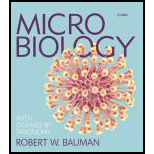
Concept explainers
Clinical Case Study Legionella in the Produce Aisle

Legionnaires’ disease, or legionellosis, is a potentially fatal respiratory disease caused by the growth of a bacterium, Legionella pneumophila, in the lungs of patients. The bacterium enters humans via the respiratory portal in aerosols produced by cooling towers, air conditioners, whirlpool baths, showers, humidifiers, and respiratory therapy equipment. Several years ago, the Louisiana state health department received reports of 33 cases of Legionnaires’ disease in the town of Bogalusa. LA (population 16,000).
Epidemiologists tried to ascertain the source of Bogalusa’s outbreak of Legionnaires’ disease by interviewing the victims and their relatives to develop complete histories and to identify areas of commonality among the victims that nonvictims did not share. Victims included a range of ages, occupations, hobbies, religions, and types and locations of dwellings. Although no significant differences were identified among the lifestyles, ages, or smoking habits of victims and nonvictims, one curious fact was discovered: all the victims did their grocery shopping at the same store. However, healthy individuals also shopped at that store.
The air-conditioning system of the grocery store proved to be free of Legionella, but the vegetable misting machine did not. The strain of Legionella isolated from the misting machine was identical to the strain recovered from the victims’ lungs.
- 1. Would this outbreak be classified as endemic, epidemic, or pandemic?
- 2. Is this a descriptive, analytical, or experimental epidemiological study?
- 3. Knowing the epidemiology and causative agent of Legionnaires’ disease, what questions would you ask of the victims or of their surviving relatives?
- 4. What, as an epidemiologist, would you examine at the store?
- 5. How did the victims become contaminated? Why didn’t everyone who bought vegetables at the store get legionellosis? What could the owners of the store do to limit or prevent future infections?
Want to see the full answer?
Check out a sample textbook solution
Chapter 14 Solutions
Microbiology with Diseases by Taxonomy (5th Edition)
- Identify the indicated tissue? (stem x.s.) parenchyma collenchyma sclerenchyma ○ xylem ○ phloem none of thesearrow_forwardWhere did this structure originate from? (Salix branch root) epidermis cortex endodermis pericycle vascular cylinderarrow_forwardIdentify the indicated tissue. (Tilia stem x.s.) parenchyma collenchyma sclerenchyma xylem phloem none of thesearrow_forward
- Identify the indicated structure. (Cucurbita stem l.s.) pit lenticel stomate tendril none of thesearrow_forwardIdentify the specific cell? (Zebrina leaf peel) vessel element sieve element companion cell tracheid guard cell subsidiary cell none of thesearrow_forwardWhat type of cells flank the opening on either side? (leaf x.s.) vessel elements sieve elements companion cells tracheids guard cells none of thesearrow_forward
- What specific cell is indicated. (Cucurbita stem I.s.) vessel element sieve element O companion cell tracheid guard cell none of thesearrow_forwardWhat specific cell is indicated? (Aristolochia stem x.s.) vessel element sieve element ○ companion cell O O O O O tracheid O guard cell none of thesearrow_forwardIdentify the tissue. parenchyma collenchyma sclerenchyma ○ xylem O phloem O none of thesearrow_forward
- Please answer q3arrow_forwardRespond to the following in a minimum of 175 words: How might CRISPR-Cas 9 be used in research or, eventually, therapeutically in patients? What are some potential ethical issues associated with using this technology? Do the advantages of using this technology outweigh the disadvantages (or vice versa)? Explain your position.arrow_forwardYou are studying the effect of directional selection on body height in three populations (graphs a, b, and c below). (a) What is the selection differential? Show your calculation. (2 pts) (b) Which population has the highest narrow sense heritability for height? Explain your answer. (2 pts) (c) If you examined the offspring in the next generation in each population, which population would have the highest mean height? Why? (2 pts) (a) Midoffspring height (average height of offspring) Short Short Short Short (c) Short (b) Short Tall Short Tall Short Short Tall Midparent height (average height of Mean of population = 65 inches Mean of breading parents = 70 inches Mean of population = 65 inches Mean of breading parents = 70 inches Mean of population = 65 inches Mean of breading parents = 70 inchesarrow_forward
- Understanding Health Insurance: A Guide to Billin...Health & NutritionISBN:9781337679480Author:GREENPublisher:Cengage
 Medical Terminology for Health Professions, Spira...Health & NutritionISBN:9781305634350Author:Ann Ehrlich, Carol L. Schroeder, Laura Ehrlich, Katrina A. SchroederPublisher:Cengage Learning
Medical Terminology for Health Professions, Spira...Health & NutritionISBN:9781305634350Author:Ann Ehrlich, Carol L. Schroeder, Laura Ehrlich, Katrina A. SchroederPublisher:Cengage Learning Biology: The Unity and Diversity of Life (MindTap...BiologyISBN:9781305073951Author:Cecie Starr, Ralph Taggart, Christine Evers, Lisa StarrPublisher:Cengage Learning
Biology: The Unity and Diversity of Life (MindTap...BiologyISBN:9781305073951Author:Cecie Starr, Ralph Taggart, Christine Evers, Lisa StarrPublisher:Cengage Learning  Microbiology for Surgical Technologists (MindTap ...BiologyISBN:9781111306663Author:Margaret Rodriguez, Paul PricePublisher:Cengage Learning
Microbiology for Surgical Technologists (MindTap ...BiologyISBN:9781111306663Author:Margaret Rodriguez, Paul PricePublisher:Cengage Learning





